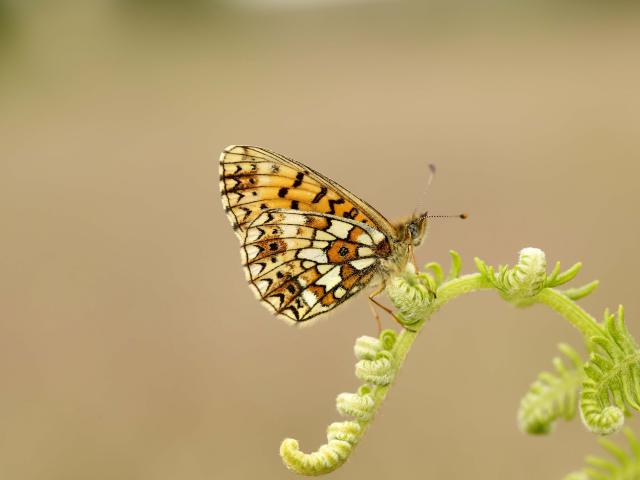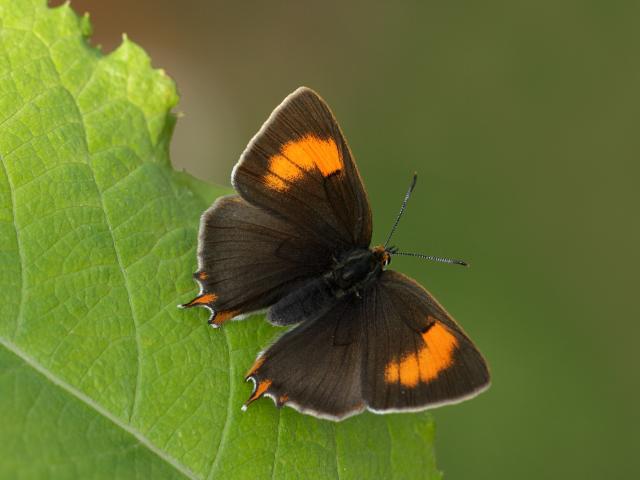Farmland is an important habitat for butterflies and moths along with a wealth of other wildlife. Butterfly Conservation are collaborating with Natural England on a project to ensure that landowners and managers are able to manage their land to benefit our most threatened butterfly species.

Butterflies and moths play an important role in the natural ecosystem as pollinators and as food for other species. They are often seen as indicators of a healthy environment but farmland butterflies have declined by by 37% since 2005 and 57% since 1979.
Environmentally-friendly farming schemes have been in existence for a number of years and serve to support farmers in maintaining or instigating more sympathetic and less-intensive farming methods to provide habitat for wildlife. Some butterfly species are starting to benefit from these schemes, including some of our most rapidly declining species, but others are not faring so well. Over the last 10 years in England, the Higher Level Stewardship (HLS) element of Environmental Stewardship has been giving struggling species an extra helping hand.
The Farmland Butterfly and Moth Initiative (FBMI) was launched in May 2012 and is working with Natural England Advisers who are supporting farmers with land of high nature value to ensure that farming practices are tailored to the needs of butterfly species. In 2015, Environmental Stewardship came to a close and was replaced by Countryside Stewardship. The FBMI project enabled Natural England to use our Butterflies for the New Millennium data, collected by staff and volunteers, to design the way in which the new Countryside Stewardship Scheme would be targeted.
The FBMI focuses on ten of our most endangered butterfly species; such as the Duke of Burgundy, which has been reduced to around 100 sites, the High Brown Fritillary which has declined to about 50 sites and the Heath Fritillary, in existence on only 40 remaining sites. Other targeted species include the Marsh Fritillary, Lulworth Skipper, Pearl-bordered Fritillary, Small Pearl-bordered Fritillary, Glanville Fritillary, Wood White and Brown Hairstreak.

In addition, Countryside Stewardship is also targeted to increase the number of Higher-tier agreements that support 16 priority moth species. The FBMI project has generated the data and species guidance for the target butterflies and moths for advisers to decide where and how to spend money on conserving species in the farmed landscape. Sites are being targeted under the government’s Higher-tier Countryside Stewardship Scheme where farmers will receive highly tailored guidance from local Natural England Advisers and Butterfly Conservation staff.
It’s not all about the rare and declining species, as common and widespread species are showing worrying trends in the wider countryside. Within Countryside Stewardship there is a package of measures called the ‘Wild Pollinator and Farm Wildlife Package’ which we are supporting and promoting. This package aims to provide the following three elements to boost wildlife in the wider farmed landscape: Nectar and pollen sources/chick-food, overwinter seed food for birds, suitable breeding/shelter/nesting habitat. Butterfly Conservation is also part of a UK-wide partnership led by the RSPB to develop best practice wildlife management advice for farmers.
Contacts
Katie Cruickshanks, Farmland Butterfly and Moth Initiative Officer, Butterfly Conservation
James Phillips, Species Recovery Programme, Natural England
Funders
Species Factsheets
FBMI Countryside Stewardship Prescription Sets- butterflies
FBMI CS prescription set- Brown Hairstreak
FBMI CS prescription set- Duke of Burgundy
FBMI CS prescription set- Heath Fritillary
FBMI CS prescription set- High Brown Fritillary
FBMI CS prescription set- Lulworth Skipper
FBMI CS prescription set- Marsh Fritillary
FBMI CS prescription set- Pearl-bordered Fritillary
FBMI CS prescription set- Small Pearl-bordered Fritillary
FBMI CS prescription set- Wood White
FBMI Countryside Stewardship Prescription Sets- moths
FBMI CS prescription set- Barberry Carpet
FBMI CS prescription set- Basil-thyme Case-bearer (Coleophora tricolor)
FBMI CS prescription set- Black-veined moth
FBMI CS prescription set- Fisher's Estuarine moth
FBMI CS prescription set- Greenweed Flat-body (Agonopterix atomella)
FBMI CS prescription set- Grey Carpet
FBMI CS prescription set- Liquorice Piercer (Grapholita pallifrontana)
FBMI CS prescription set- Lunar Yellow Underwing
FBMI CS prescription set- Marsh Mallow moth
FBMI CS prescription set- Mistletoe Marble (Celypha woodiana)
FBMI CS prescription set- Netted Carpet
FBMI CS prescription set- Shoulder-striped Clover
FBMI CS prescription set- Straw Belle
FBMI CS prescription set- Striped Lychnis
FBMI CS prescription set- Water-dock Case-bearer (Coleophora hydrolapathella)
FBMI CS prescription set- White-spotted Sable (Anania funebris)

